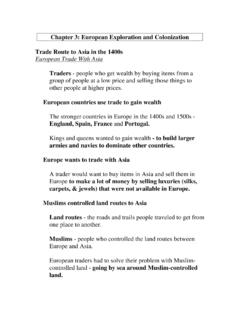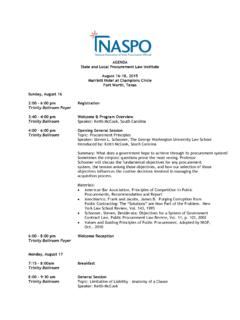Transcription of The Northern Economy and Industrialization …
1 Chapter 17: The North After the Civil War The Northern Economy and Industrialization Changes in the North Population Two ways the changed between 1800 and 1860 = size & population Beginning of Industrialization Another way that the changed from 1800 to 1960 = Economy (agricultural Economy industrial Economy ). Industrialization = the growth of Economy in which most people change from farm work to factory work Northern part of the = did nearly all the manufacturing The Civil War affected Industrialization by increasing coal-mining and production of war supplies. The Union blockade limited Industrialization in the South during the Civil War. Some of the ways that the Northern changed after the Civil War: a. increasing the production of consumer goods b. increasing new immigrants and jobs in the Northern cities c. increasing larger cities and factories d. the became a large, industrialized country The Economy of the East Coast region centered on after Civil War = major international seaports (New York, New Jersey, & Pennsylvania).
2 The Economy of the Great Lakes region based on after the Civil War = the production of steel and steel products Pittsburgh The world's largest steel producer Cleveland The center for oil refining Chicago The largest rail center in the world Factors of the Northern Economy 1. Tools and equipment 2. Labor 3. Natural resources 4. Transportation 5. Money and credit 6. Demand 7. Profit The Tools and Equipment Factor Inventions Transportation Communication Agriculture Electric streetcar Telegraph (1856) Corn planter (1853). (1874) Telephone (1876) Combine (1860). Gas-powered Wireless telegraph automobile (1896) (1895). Patent = a legal document giving one person or group the right to make, use, or sell an invention Machinists = people who made and repaired the new machines A new way to make products Unique parts = parts that are only one of a kind Interchangeable Parts Samuel Colt = first person who began using interchangeable parts (parts that are the same in each product).
3 Interchangeable parts could make products less expensive because they cut down the amount of labor of making unique parts. Assembling products with many parts ( reapers) took a lot of time because it still required great amount of labor. Assembly line Assembly line made production faster because it saved time for a worker to find the right part or change tools. Efficiency Fred Taylor (famous efficiency engineer) thought the workers could assemble products more quickly if the motions of workers were simplified. He tried to improve the efficiency of assembly line workers by letting them use different tools or motion. The best example of the assembly line = Ford's Detroit assembly plant Increased production The effect of interchangeable parts and the assembly line = greatly increased the industrial production of Northern factories, brought more money to the Small manufacturers can't compete Mass production = using interchangeable parts and assembly lines to manufacture enormous amounts of products The effect of mass production on small businesses = put them out of business The Other Factors of the Northern Economy The Labor Factor The largest group of people that moved to Northern cities = immigrants from Europe Immigrants in the 1800s were different from earlier immigrants because they were uneducated and had few skills.
4 They looked for factory, construction, & railroad jobs. The growth of one city Chicago to grow so rapidly because it became a. a center of many railroads b. meat packing center of the nation c. banking and financial center for the Great Plains and the West d. the mail order center for the Midwest The Natural Resource Factor Advantages for locating factories in cities rather than near natural resources: a. more labor b. demand for products was highest Factories couldn't locate in cities in early 1800s = natural resources couldn't be transported to cities. Natural Resources Transported Citie to the North Oil Wool Cotton Grains Coal Pen Vir The Transportation Factor Regional and national transportation Change in Transportation: Before Civil War: Barges moved whet and corn across canals, lakes, and rivers After Civil War: Railroads replaced barges and ships and became most important form of transportation City transportation The reason why transportation systems were needed in the cities = to move workers to and from work The problem with elevated steam trains = dirty and noisy Inventions helped solve the city transportation problem because it allowed workers to move more quickly and efficiently.
5 Transportation inventions changed better paid workers to move to residential areas that were more pleasant and less crowded than the central cities. The Money and Credit Factor Private banks Many of the largest private banks located in New York & Philladelphia. J. P. Morgan = a wealthy banker who owned banks that had connections with London and Paris. He helped government and big businesses obtain loans. Loans for business Bankers could come to own railroads because the railroad owner would take out a loan and not be able to pay it back, so the bankers would come to own their railroads. No loans for farmers Northern bankers didn't want to loan money to farmers because they often did not make a profit. The Demand Factor Demand for consumer products Products in demand after Civil War = Rails, Railroad cars, & Factory machinery "Ready to wear" = the name for mass-produced, standard-sized clothing Demand for services Services that city people demanded: a.
6 Indoor plumbing b. Electricity for home usage c. Gas for lighting d. Public parks e. Amusements Profit Businesses in the North were in a position to make large profits after the Civil War because: a. Large supply of cheap labor b. Good transportation provided access to natural resources and markets c. Large companies could get money and credit to buy good equipment and tools d. Demand for products was great Businesses increased in number and size Two leading industries in the in the 1890s = steel & railroads Companies began to control industry = Large manufacturing industries People's Problems from Industrialization Interchangeable Workers Mass production made factory owners look at workers as interchangeable parts. (They figured the machines did so much work the workers could easily be replaced.) This lowered worker's wages. Immigration Two reasons many Americans resented immigrants: a. They brought in new religions which was a threat to many Americans.
7 B. They filled many jobs which could have been filled by Americans The areas where the immigrants settled were called ethnic neighborhoods. Tenements (building made for one family that were remodeled to house with six or more families) were poor places to live because they were not sanitary. African Americans were only allowed to work or start small service businesses such as shoe repair, and catering. Ghettoes = the areas where African Americans settled in the cities The first people to live in ghettoes in Europe = Jewish people in 15th century The Differing Perspectives of Historians Irish workers were considered inferior and ignorant. Many places hired Irish workers because the work was dangerous at high risk. When the Irish demanded higher wages and less hours, they were fired and replaced with Chinese. The American businessmen did not respect the Irish.









